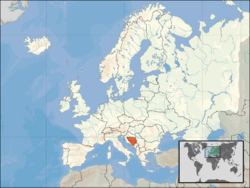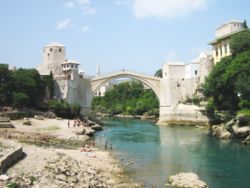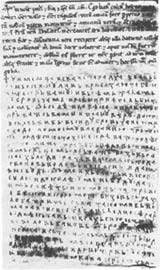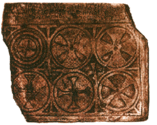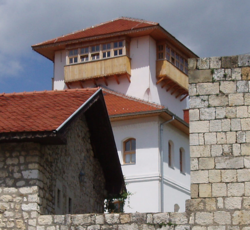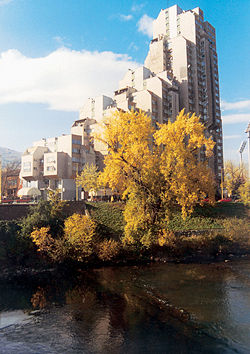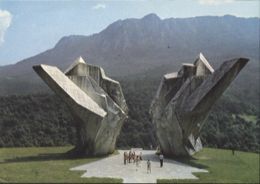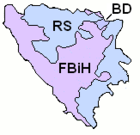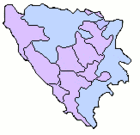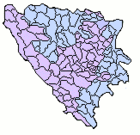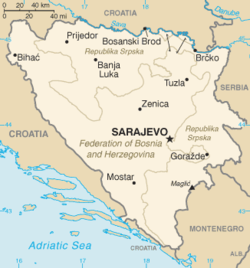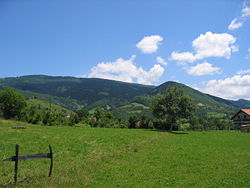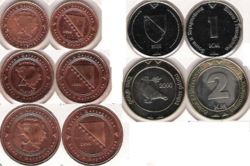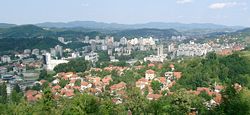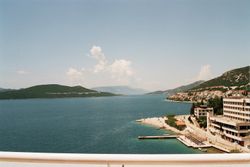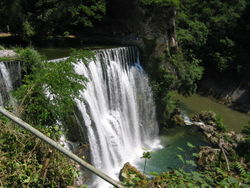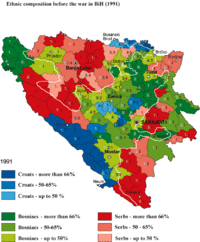Bosnia and Herzegovina
2008/9 Schools Wikipedia Selection. Related subjects: Europe; European Countries
| Bosna i Hercegovina Босна и Херцеговина Bosnia and Herzegovina
|
||||||
|---|---|---|---|---|---|---|
|
||||||
| Motto: None | ||||||
| Anthem: Državna himna Bosne i Hercegovine |
||||||
|
Location of Bosnia and Herzegovina (orange)
on the European continent (white) — [ Legend] |
||||||
| Capital (and largest city) |
Sarajevo |
|||||
| Official languages | Bosnian, Croatian and Serbian | |||||
| Demonym | Serbs, Croats, Bosniaks | |||||
| Government | Parliamentary democracy | |||||
| - | Presidency members | Željko Komšić1 Nebojša Radmanović2 Haris Silajdžić3 |
||||
| - | Chairman of the Council of Ministers |
Nikola Špirić | ||||
| - | High Representative | Miroslav Lajčák4 | ||||
| Independence | ||||||
| - | Formed | 29 August 1189 | ||||
| - | Kingdom established | 26 October 1377 | ||||
| - | Independence lost to Ottoman Empire |
1463 | ||||
| - | National Day | November 25, 1943 | ||||
| - | Independence from SFR Yugoslavia | March 1, 1992 | ||||
| - | Recognized | April 6, 1992 | ||||
| Area | ||||||
| - | Total | 51,197 km² ( 127th) 19,767 sq mi |
||||
| - | Water (%) | negligible | ||||
| Population | ||||||
| - | 2007 estimate | 3,935,000 ( 126th5) | ||||
| - | 1991 census | 4,377,053 | ||||
| - | Density | 89/km² ( 116th5) 230/sq mi |
||||
| GDP ( PPP) | Feb 2007 estimate | |||||
| - | Total | $42.998 billion ( IMF) ( 94th) | ||||
| - | Per capita | 10,715 ( ) ( 77th) | ||||
| GDP (nominal) | Feb 2007 estimate | |||||
| - | Total | $13.16 billion (IMF) | ||||
| - | Per capita | $3,306 (IMF) | ||||
| Gini (2001) | 26.2 (low) | |||||
| HDI (2004) | ▲ 0.803 (high) ( 66th) | |||||
| Currency | Convertible mark ( BAM) |
|||||
| Time zone | CET ( UTC+1) | |||||
| - | Summer ( DST) | CEST ( UTC+2) | ||||
| Internet TLD | .ba | |||||
| Calling code | +387 | |||||
| 1 | Curent presidency Chair; Croat. | |||||
| 2 | Curent presidency member; Serb. | |||||
| 3 | Curent presidency member; Bosniak. | |||||
| 4 | Not a government member; The High Representative is an international civilian peace implementation overseer with full authority to dismiss elected and non-elected officials and inaugurate legislation | |||||
| 5 | Rank based on 2007 UN estimate of de facto population. | |||||
Bosnia and Herzegovina is a country on the Balkan peninsula of Southern Europe with an area of 51,280 square kilometres (19,741 sq mi). The last official census in 1991 recorded 4.4 million people, which was prior to the 1992-1995 war, while an unofficial census in 1996 by UNHCR recorded a postwar population of 3.9 million. Its 2007 residential population is estimated at 4 million.
Formerly one of the six federal units constituting the Socialist Federal Republic of Yugoslavia, Bosnia and Herzegovina gained its independence during the Yugoslav wars of the 1990s.
The country is home to three ethnic " constituent peoples": Bosniaks, Serbs and Croats. Regardless of ethnicity, a citizen of Bosnia and Herzegovina is often identified in English as a Bosnian. In Bosnia however, the distinction between a Bosnian and a Herzegovinian is maintained as a regional, rather than an ethnic distinction. The country is politically decentralized and comprised of two governing entities, the Federation of Bosnia and Herzegovina and Republika Srpska, with District Brčko as a de facto third entity.
Bordered by Croatia to the north, west and south, Serbia to the east, and Montenegro to the south, Bosnia and Herzegovina is mostly landlocked, except for 26 kilometres of the Adriatic Sea coastline, centered around the town of Neum. The interior of the country is mountainous in the centre and south, hilly in the northwest, and flat in the northeast. The nation's capital and largest city is Sarajevo, seated between several high mountains. Sarajevo was the host site of the 1984 Winter Olympic Games.
The region of Bosnia is the largest geographic region of the modern state with moderate continental climate, marked by hot summers and cold, snowy winters. Smaller Herzegovina is the southern tip of the country, with Mediterranean climate and topography. Bosnia and Herzegovina's natural resources are abundant.
Etymology
The first preserved mention of the name "Bosnia" is in the De Administrando Imperio, a politico-geographical handbook written by Byzantine emperor Constantine VII in 958 as a component part of "Baptized Serbia," however, by this time Bosnia was mostly converted from their slavic manichaistic religion to Bogumilism (a christian sect that slavic Bulgarians spread to Bosnia). The exact meaning and origin of the word is somewhat cloudy. The name "Bosnia" most probably comes from the name of the Bosna river around which it has been historically based, which was recorded in the Roman Age under the name Bossina. More direct root of the river's names are unknown. Philologist Anton Mayer proposed a connection with the Indo-European root bos or bogh, meaning "running water". Certain Roman sources similarly mention Bathinus flumen, or the Illyrian word Bosona, both of which would mean "running water" as well. Other theories involve the rare Latin term Bosina, meaning boundary, and possible Slavic origins.
The origins of the word Herzegovina can be identified with more precision and certainty. During the Early Middle Ages the region was known as Hum or Zahumlje, named after the Zachlumoi tribe of Slavs which inhabited it. In the 1440s, the region was ruled by powerful nobleman Stefan Vukčić Kosača. In a document sent to Friedrich III on January 20, 1448, Stefan Vukčić Kosača called himself Herzog of Saint Sava, lord of Hum and Primorje, great duke of the Bosnian kingdom (Herzog means duke in German) and so the lands he controlled would later become known as Herzog's lands or Herzegovina. The name Herzegovina was first included in the official name of the then Ottoman province in the mid-nineteenth century.
On initial proclamation of independence in 1992 the country's official name was the Republic of Bosnia and Herzegovina but following the 1995 Dayton Agreement and the new constitution that came with it the name was officially changed to only Bosnia and Herzegovina.
History
Pre-Slavic period
Bosnia has been inhabited at least since Neolithic times by Illyrian tribes. In the early Bronze Age, the Neolithic population was replaced by more warlike Indo-European tribes known as the Illyres or Illyrians. Celtic migrations in the fourth century BC and third century BC displaced many Illyrian tribes from their former lands, but some Celtic and Illyrian tribes mixed. Concrete historical evidence for this period is scarce, but overall it appears that the region was populated by a number of different peoples speaking distinct languages. Conflict between the Illyrians and Romans started in 229 BC, but Rome would not complete its annexation of the region until AD 9. In the Roman period, Latin-speaking settlers from all over the Roman empire settled among the Illyrians and Roman soldiers were encouraged to retire in the region.
Some claim that Christianity arrived in the region by the end of the first century, but there are no artifacts or objects from the time testify to this. There were only two Roman Catholic churches in Bosnia-Herzegovina up until the occupation of Austro-Hungary, and no Serb Orthodox churches at all. However, the Fransciscans founded their permanent missions in Bosnia as early as the 11th century. The land originally was part of the Illyria up until the Roman occupation. Following the split of the Roman Empire between 337 and 395, Dalmatia and Pannonia became parts of the Western Roman Empire. Some claim that the region was conquered by the Ostrogoths in 455. It subsequently changed hands between the Alans and Huns. By the sixth century, Emperor Justinian had reconquered the area for the Byzantine Empire. The Slavs, a people from eastern Europe (now territory of Ukraine), were conquered by the Avars in the sixth century.
Medieval Bosnia
Modern knowledge of the political situation in the west Balkans during the Dark Ages is patchy and confusing. Upon their arrival, the Slavs brought with them a tribal social structure, which probably fell apart and gave way to Feudalism only with Frankish penetration into the region in the late ninth century. It was also around this time that the south Slavs were Christianized. Bosnia, due to its geographic position and terrain, was probably one of the last areas to go through this process, which presumably originated from the urban centers along the Dalmatian coast. The principalities of Serbia and Croatia split control of Bosnia and Herzegovina in the ninth and tenth century, but by the High Middle Ages political circumstance led to the area being contested between the Kingdom of Hungary and the Byzantine Empire. Following another shift of power between the two in the early twelfth century, Bosnia found itself outside the control of both and emerged as an independent state under the rule of local bans.
The first notable Bosnian monarch, Ban Kulin, presided over nearly three decades of peace and stability during which he strengthened the country's economy through treaties with Dubrovnik and Venice. His rule also marked the start of a controversy with the Bosnian Church, an indigenous Christian sect considered heretical by both the Roman Catholic and Eastern Orthodox churches. In response to Hungarian attempts to use church politics regarding the issue as a way to reclaim sovereignty over Bosnia, Kulin held a council of local church leaders to renounce the heresy and embraced Catholicism in 1203. Despite this, Hungarian ambitions remained unchanged long after Kulin's death in 1204, waning only after an unsuccessful invasion in 1254.
Bosnian history from then until the early fourteenth century was marked by the power struggle between the Šubić and Kotromanić families. This conflict came to an end in 1322, when Stjepan II Kotromanić became ban. By the time of his death in 1353, he was successful in annexing territories to the north and west, as well as Zahumlje and parts of Dalmatia. He was succeeded by his nephew Tvrtko who, following a prolonged struggle with nobility and inter-family strife, gained full control of the country in 1367. Tvrtko crowned himself on 26 October 1377 as Stefan Tvrtko I by the mercy of God King of Serbs, Bosnia and the Seaside and the Western Lands.
Historians considered that he was crowned in the Serbian Orthodox Mileševa monastery, even though there is no archeological evidences. Another possibility, advanced by P. Anđelić and based on archeological evidence, is that he was crowned in Mile near Visoko in the church which was built in time of Stephen II Kotromanić's reign, where he was also buried alongside his uncle Stjepan II. Following his death in 1391 however, Bosnia fell into a long period of decline. The Ottoman Empire had already started its conquest of Europe and posed a major threat to the Balkans throughout the first half of the fifteenth century. Finally, after decades of political and social instability, Bosnia officially fell in 1463. Herzegovina would follow in 1482, with a Hungarian-backed reinstated "Bosnian Kingdom" being the last to succumb in 1527.
Ottoman era
The Ottoman conquest of Bosnia marked a new era in the country's history and introduced tremendous changes in the political and cultural landscape of the region. Although the kingdom had been crushed and its high nobility executed, the Ottomans nonetheless allowed for the preservation of Bosnia's identity by incorporating it as an integral province of the Ottoman Empire with its historical name and territorial integrity - a unique case among subjugated states in the Balkans. Within this sandžak (and eventual vilayet) of Bosnia, the Ottomans introduced a number of key changes in the territory's socio-political administration; including a new landholding system, a reorganization of administrative units, and a complex system of social differentiation by class and religious affiliation.
The four centuries of Ottoman rule also had a drastic impact on Bosnia's population make-up, which changed several times as a result of the empire's conquests, frequent wars with European powers, migrations, and epidemics. A native Slavic-speaking Muslim community emerged and eventually became the largest of the ethno-religious groups (mainly as a result of a gradually rising number of conversions to Islam), while a significant number of Sephardi Jews arrived following their expulsion from Spain in the late fifteenth century. The Bosnian Christian communities also experienced major changes. The Bosnian Franciscans (and the Catholic population as a whole) were protected by official imperial decree. The Orthodox community in Bosnia, initially confined to Herzegovina and Podrinje, spread throughout the country during this period and went on to experience relative prosperity until the nineteenth century. Meanwhile, the schismatic Bosnian Church disappeared altogether.
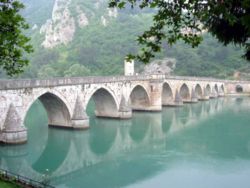
As the Ottoman Empire thrived and expanded into Central Europe, Bosnia was relieved of the pressures of being a frontier province and experienced a prolonged period of general welfare and prosperity. A number of cities, such as Sarajevo and Mostar, were established and grew into major regional centers of trade and urban culture. Within these cities, various Sultans and governors financed the construction of many important works of Bosnian architecture (such as the Stari most and Gazi Husrev-beg's Mosque). Furthermore, numerous Bosnians played influential roles in the Ottoman Empire's cultural and political history during this time. Bosnian soldiers formed a large component of the Ottoman ranks in the battles of Mohács and Krbava field, two decisive military victories, while numerous other Bosnians rose through the ranks of the Ottoman military bureaucracy to occupy the highest positions of power in the Empire, including admirals, generals, and grand viziers. Many Bosnians also made a lasting impression on Ottoman culture, emerging as mystics, scholars, and celebrated poets in the Turkish, Arabic, and Persian languages.
However, by the late seventeenth century the Empire's military misfortunes caught up with the country, and the conclusion of the Great Turkish War with the treaty of Karlowitz in 1699 once again made Bosnia the Empire's westernmost province. The following hundred years were marked by further military failures, numerous revolts within Bosnia, and several outbursts of plague. The Porte's efforts at modernizing the Ottoman state were met with great hostility in Bosnia, where local aristocrats stood to lose much through the proposed reforms. This, combined with frustrations over political concessions to nascent Christian states in the east, culminated in a famous (albeit ultimately unsuccessful) revolt by Husein Gradaščević in 1831. Related rebellions would be extinguished by 1850, but the situation continued to deteriorate. Later agrarian unrest eventually sparked the Herzegovinian rebellion, a widespread peasant uprising, in 1875. The conflict rapidly spread and came to involve several Balkan states and Great Powers, which eventually forced the Ottomans to cede administration of the country to Austria-Hungary through the treaty of Berlin in 1878.
Austro-Hungarian rule
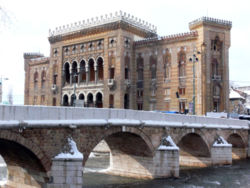
Though an Austro-Hungarian occupying force quickly subjugated initial armed resistance upon take-over, tensions remained in certain parts of the country (particularly Herzegovina) and a mass emigration of predominantly Muslim dissidents occurred. Some think that it was a planned Austro-Hungarian takeover of the land called Herzegovina because many Croats from Croatia were settled there. However, a state of relative stability was reached soon enough and Austro-Hungarian authorities were able to embark on a number of social and administrative reforms which intended to make Bosnia and Herzegovina into a "model colony". With the aim of establishing the province as a stable political model that would help dissipate rising South Slav nationalism, Habsburg rule did much to codify laws, to introduce new political practices, and generally to provide for modernization. The Austro-Hungarian empire built the three Roman Catholic churches in Sarajevo and these three churches are among the only 20 Catholic churches in the state of Bosnia. Although successful economically, Austro-Hungarian policy - which focused on advocating the ideal of a pluralist and multi-confessional Bosnian nation (largely favored by the Muslims) - failed to curb the rising tides of nationalism. The concept of Croat and Serb nationhood had already spread to Bosnia and Herzegovina's Catholics and Orthodox communities from neighboring Croatia and Serbia in the mid nineteenth century, and was too well-entrenched to allow for the wide-spread acceptance of a parallel idea of Bosnian nationhood. By the latter half of the 1910s, nationalism was an integral factor of Bosnian politics, with national political parties corresponding to the three groups dominating elections. The idea of a unified South Slavic state (typically expected to be spear-headed by independent Serbia) became a popular political ideology in the region at this time, including in Bosnia and Herzegovina. The Austro-Hungarian government's decision to formally annex Bosnia-Herzegovina in 1908 (see Bosnian Crisis) added to a sense of urgency among these nationalists. The political tensions caused by all this culminated on June 28, 1914, when Serb nationalist youth Gavrilo Princip assassinated the heir to the Austro-Hungarian throne, Archduke Franz Ferdinand, in Sarajevo; an event that proved to be the spark that set off World War I. Although some Bosnians died serving in the armies of the various warring states, Bosnia and Herzegovina itself managed to escape the conflict relatively unscathed.
The first Yugoslavia
Following the war, Bosnia was incorporated into the South Slav kingdom of Serbs, Croats and Slovenes (soon renamed Yugoslavia). Political life in Bosnia at this time was marked by two major trends: social and economic unrest over property redistribution, and formation of several political parties that frequently changed coalitions and alliances with parties in other Yugoslav regions. The dominant ideological conflict of the Yugoslav state, between Croatian regionalism and Serbian centralization, was approached differently by Bosnia's major ethnic groups and was dependent on the overall political atmosphere. Even though there were over three million Bosnians in Yugoslavia, outnumbering Slovenes and Montenegrins combined, Bosnian nationhood was denied by the new Kingdom. Although the initial split of the country into 33 oblasts erased the presence of traditional geographic entities from the map, the efforts of Bosnian politicians such as Mehmed Spaho ensured that the six oblasts carved up from Bosnia and Herzegovina corresponded to the six sanjaks from Ottoman times and, thus, matched the country's traditional boundary as a whole.
The establishment of the Kingdom of Yugoslavia in 1929, however, brought the redrawing of administrative regions into banates that purposely avoided all historical and ethnic lines, removing any trace of a Bosnian entity. Serbo-Croat tensions over the structuring of the Yugoslav state continued, with the concept of a separate Bosnian division receiving little or no consideration. The famous Cvetković- Maček agreement that created the Croatian banate in 1939 encouraged what was essentially a partition of Bosnia between Croatia and Serbia. However, outside political circumstances forced Yugoslav politicians to shift their attention to the rising threat posed by Adolf Hitler's Nazi Germany. Following a period that saw attempts at appeasement, the signing of the Tripartite Treaty, and a coup d'état, Yugoslavia was finally invaded by Germany on April 6, 1941.
World War II
Once the kingdom of Yugoslavia was conquered by Nazi forces in World War II, all of Bosnia was ceded to the Independent State of Croatia. The Nazi rule over Bosnia led to widespread persecution of Jewish, Serbian and Gypsy civilians. The Jewish population was nearly exterminated and roughly 700,000 Serbs died as a result of genocide perpetrated by the Croatian Ustasha. Many Serbs in the area took up arms and joined the Chetniks; a Serb nationalist and royalist resistance movement that conducted guerrilla warfare against the Nazis and the communist Partisans. The Chetniks received initial support from the UK and USA.
Starting in 1941, Yugoslav communists under the leadership of Josip Broz Tito organized their own multi-ethnic resistance group, the partisans, who fought against both Axis and Chetnik forces. On November 25, 1943 the Anti-Fascist Council of National Liberation of Yugoslavia with Tito at its helm held a founding conference in Jajce where Bosnia and Herzegovina was reestablished as a republic within the Yugoslavian federation in its Habsburg borders. Military success eventually prompted the Allies to support the Partisans, but Josip Broz Tito declined their offer to help and relied on his own forces instead. Eventually the end of the war resulted in the establishment of the Socialist Federal Republic of Yugoslavia, with the constitution of 1946 officially making Bosnia and Herzegovina one of six constituent republics in the new state.
Socialist Yugoslavia
Because of its central geographic position within the Yugoslavian federation, post-war Bosnia was strategically selected as a base for the development of the military defense industry. This contributed to a large concentration of arms and military personnel in Bosnia; a significant factor in the war that followed the break-up of Yugoslavia in the 1990s. However, Bosnia's existence within Yugoslavia, for the large part, was peaceful and prosperous. Though considered a political backwater of the federation for much of the 50s and 60s, the 70s saw the ascension of a strong Bosnian political elite fueled in part by Tito's leadership in the non-aligned movement and Bosniacs serving in Yugoslavia's diplomatic corps. While working within the communist system, politicians such as Džemal Bijedić, Branko Mikulić and Hamdija Pozderac reinforced and protected the sovereignty of Bosnia and Herzegovina Their efforts proved key during the turbulent period following Tito's death in 1980, and are today considered some of the early steps towards Bosnian independence. However, the republic hardly escaped the increasingly nationalistic climate of the time unscathed. With the fall of communism and the start of the break-up of Yugoslavia, the old communist doctrine of tolerance began to lose its potency, creating an opportunity for nationalist elements in the society to spread their influence.
The 1992-1995 Bosnian War
The 1990 parliamentary elections led to a national assembly dominated by three ethnically-based parties, which had formed a loose coalition to oust the communists from power. Croatia and Slovenia's subsequent declarations of independence and the warfare that ensued placed Bosnia and Herzegovina and its three constituent peoples in an awkward position. A significant split soon developed on the issue of whether to stay with the Yugoslav federation (overwhelmingly favored among Serbs) or seek independence (overwhelmingly favored among Bosniaks and Croats). A declaration of sovereignty in October 1991 was followed by a referendum for independence from Yugoslavia in February and March 1992 boycotted by the great majority of Bosnian Serbs. The turnout in the independence referendum was 63.7% and 99.4% voted for independence. The controversy lies in the fact that the referendum failed to surpass the constitutional two-third required majority. But Bosnia and Herzegovina declared independence nevertheless Following a tense period of escalating tensions and sporadic military incidents, open warfare began in Sarajevo on April 6.
International recognition of Bosnia and Herzegovina increased diplomatic pressure for the Yugoslav People's Army (JNA) to withdraw from the republic's territory which they officially did. However, in fact, the Bosnian Serb members of JNA simply changed insignia, formed the Army of Republika Srpska, and continued fighting. Armed and equipped from JNA stockpiles in Bosnia, supported by volunteers and various paramilitary forces from Serbia, and receiving extensive humanitarian, logistical and financial support from the Federal Republic of Yugoslavia, Republika Srpska's offensives in 1992 managed to place much of the country under its control. By 1993, when an armed conflict erupted between the Sarajevo government and the Croat statelet of Herzeg-Bosnia, about 70% of the country was controlled by Republika Srpska. The ethnic cleansing and civil rights violations against non-serbs were rampant in these areas. Until today the DNA teams are still digging through the mass graves which were left as a result of the campaign. One single most prominent example is the Massacre of Srebrenica, ruled genocide by the Hague Tribunal. The third war party, Bosnian Muslims, also called Bosniaks, was supported financially or otherwise by some pro-Islamic countries in the Middle East and Asia.
In March 1994, the signing of the Washington accords between the leaders of the republican government and Herzeg-Bosnia led to the creation of a joint Bosniak-Croat Federation of Bosnia and Herzegovina. The signing of the Dayton Agreement in Dayton, Ohio by the presidents of Bosnia and Herzegovina ( Alija Izetbegović), Croatia ( Franjo Tuđman), and Yugoslavia ( Slobodan Milošević) brought a halt to the fighting, roughly establishing the basic structure of the present-day state. The number of identified victims is currently at 97,207, and the recent research estimates the total number to be less than 110,000 killed (civilians and military), and 1.8 million displaced. This is being addressed by the International Commission on Missing Persons.
The Bosnian government charged Serbia of complicity in genocide in Bosnia during the war at the International Court of Justice (ICJ). In its verdict (2007), the Court found that Serbia had not committed or conspired to commit genocide. It also concluded that Serbia was not complicit in genocide. It also dismissed Bosnian claims that genocide has been committed on the whole territory of Bosnia and Herzegovina. It did, however, find that Serbia had violated the obligation under the Genocide Convention to prevent the specific instance of genocide that occurred at Srebrenica in 1995.
Politics and government
As a result of the Dayton Accords, the civilian peace implementation is supervised by the High Representative for Bosnia and Herzegovina selected by the Peace Implementation Council. The High Representative has many governmental and legislative powers, including the dismissal of elected and non-elected officials. More recently, several central institutions have been established (such as defense ministry, security ministry, state court, indirect taxation service etc.) in the process of transferring part of the jurisdiction from the entities to the state.
Bosnia and Herzegovina's governments representation is by elites who represent the country's three major groups, with each having a guaranteed share of power.
The Chair of the Presidency of Bosnia and Herzegovina rotates among three members ( Bosniak, Serb, Croat), each elected as the Chair for an eight-month term within their four-year term as a member. The three members of the Presidency are elected directly by the people (Federation votes for the Bosniak/Croat, Republika Srpska for the Serb).
The Chair of the Council of Ministers is nominated by the Presidency and approved by the House of Representatives. He or she is then responsible for appointing a Foreign Minister, Minister of Foreign Trade, and others as appropriate.
The Parliamentary Assembly is the lawmaking body in Bosnia and Herzegovina. It consists of two houses: the House of Peoples and the House of Representatives. The House of Peoples includes 15 delegates, two-thirds of which come from the Federation (5 Croat and 5 Bosniaks) and one-third from the Republika Srpska (5 Serbs). The House of Representatives is composed of 42 Members, two-thirds elected from the Federation and one-third elected from the Republika Srpska.
The Constitutional Court of Bosnia and Herzegovina is the supreme, final arbiter of legal matters. It is composed of nine members: four members are selected by the House of Representatives of the Federation,two by the Assembly of the Republika Srpska, and three by the President of the European Court of Human Rights after consultation with the Presidency.
However, the highest political authority in the country is the High Representative in Bosnia and Herzegovina, the chief executive officer for the international civilian presence in the country. Since 1995, the High Representative was able to bypass the elected parliamentary assembly or to remove elected officials. The methods selected by the High Representative are often seen as dictatorship .
Administrative divisions
Bosnia and Herzegovina has several levels of political structuring under the federal government level. Most important of these levels is the division of the country into two entities: Republika Srpska and the Federation of Bosnia and Herzegovina. The Federation of Bosnia and Herzegovina covers some 51% of Bosnia and Herzegovina's total area, while Republika Srpska covers around 49%. The entities, based largely on the territories held by the two warring sides at the time, were formally established by the Dayton peace agreement in 1995 due to the tremendous changes in Bosnia and Herzegovina's ethnic structure. Since 1996 the power of the entities relative to the federal government has decreased significantly. Nonetheless, entities still have numerous powers to themselves. The Brčko federal district in the north of the country was created in 2000 out of land from both entities. It officially belongs to both, but is governed by neither, and functions under a decentralized system of local government. The Brčko district has been praised for maintaining a multiethnic population and a level of prosperity significantly above the national average.
The third level of Bosnia and Herzegovina's political subdivision is manifested in cantons. They are unique to the Federation of Bosnia and Herzegovina entity, which consists of ten of them. All of them have their own cantonal government, which is under the law of the Federation as a whole. Some cantons are ethnically mixed and have special laws implemented to ensure the equality of all constituent peoples.
The fourth level of political division in Bosnia and Herzegovina are the municipalities. The Federation of Bosnia and Herzegovina is divided in 74 municipalities, and Republika Srpska in 63. Municipalities also have their own local government, and are typically based around the most significant city or place in their territory. As such, many municipalities have a long tradition and history with their present boundaries. Some others, however, were only created following the recent war after traditional municipalities were split by the IEBL. Each canton in the Federation of Bosnia and Herzegovina consists of several municipalities, with the municipalities themselves further divided into local communities.
Besides entities, cantons, and municipalities, Bosnia and Herzegovina also has four "official" cities. These are: Banja Luka, Mostar, Sarajevo, and East Sarajevo. The territory and government of the cities of Banja Luka and Mostar corresponds to the municipalities of the same name, while the cities of Sarajevo and East Sarajevo officially consist of several municipalities. Cities have their own city government whose power is in between that of the municipalities and cantons (or the entity, in the case of Republika Srpska).
Geography
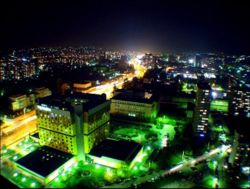
Bosnia is located in the western Balkans, bordering Croatia (932 km) to the north and south-west, Serbia (302 km) to the east, and Montenegro (225 km) to the southeast. The country is mostly mountainous, encompassing the central Dinaric Alps. The northeastern parts reach into the Pannonian basin, while in the south it borders the Adriatic. The country has only 20 kilometres (12 mi) of coastline, around the town of Neum in the Herzegovina-Neretva Canton, although surrounded by Croatian peninsulas it is possible to get to the middle of the Adriatic from Neum. Although the city is surrounded by Croatian peninsulas, by United Nations law, Bosnia has a right of passage to the outer sea. Neum has many hotels and is an important tourism destination.
The country's name comes from the two regions Bosnia and Herzegovina, which have a very vaguely defined border between them. Bosnia occupies the northern areas which are roughly four fifths of the entire country, while Herzegovina occupies the rest in the south part of the country.
The major cities are the capital Sarajevo, Banja Luka in the northwest region known as Bosanska Krajina, Bijeljina and Tuzla in the northeast, Zenica in the central part of Bosnia and Mostar, the capital of Herzegovina.
The south part of Bosnia has Mediterranean climate and a great deal of agriculture. Central Bosnia is the most mountainous part of Bosnia featuring predominate mountains Vlasic, Cvrsnica, and Prenj. Eastern Bosnia also features mountains like Trebevic, Jahorina, Igman, Bjelasnica and Treskavica. It was here that the Olympic games were held in 1984.
Eastern Bosnia is heavily forested along the river Drina, and overall close to 50% of Bosnia and Herzegovina is forested. Most forest areas are in Central, Eastern and Western parts of Bosnia. Northern Bosnia contains very fertile agricultural land along the river Sava and the corresponding area is heavily farmed. This farmland is a part of the Parapannonian Plain stretching into neighbouring Croatia and Serbia. The river Sava and corresponding Posavina river basin hold the cities of Brcko, Bosanski Samac, Bosanski Brod and Bosanska Gradiska.
The northwest part of Bosnia is called Bosanska Krajina and holds the cities of Banja Luka, Sanski Most, Cazin, Velika Kladisa and Bihać. Kozara National Park is in this forested region.
There are seven major rivers in the Republic of Bosnia and Herzegovina: The Una river in the northwest part of Bosnia flows along the northern and western border of Bosnia and Croatia and through the Bosnian city of Bihac. It is a very beautiful river and popular for rafting and adventure sports.
The Sana flows through the city of Sanski Most and is a tributary of the river Sava in the north.
The Vrbas flows through the cities of Gornji Vakuf - Uskoplje, Bugojno, Jajce and Banja Luka and reaches the river Sava in the north. The Vrbas flows through the central part of Bosnia and flows outwards to the North.
The River Bosna is the longest river in Bosnia and is fully contained within the country as it stretches from its source near Sarajevo to the river Sava in the north.
The Drina flows through the eastern part of Bosnia, at many places in the border between Bosnia and Serbia. The Drina flows through the cities of Foca, Gorazde and Visegrad.
The Neretva river is a large river in Central and Southern Bosnia, flowing from Jablanica south to the Adriatic Sea. The river is famous as it flows through the famous city of Mostar.
The Sava river is the largest river in Bosnia and Herzegovina but not the largest river that is flowing through Bosnia and Herzegovina. The Sava river flows through Serbia, Bosnia and Herzegovina and Croatia. Sava is making a natural border between Bosnia and Herzegovina and Croatia and towns like Brcko, Bosanski Samac, Bosanska Gradiska lies on the river.
Economy
Bosnia faces the dual problem of rebuilding a war-torn country and introducing market reforms to its formerly centrally-planned economy. One legacy of the previous era is a greatly overstaffed military industry; under former leader Josip Broz Tito, military industries were promoted in the republic, resulting in the development of a large share of Yugoslavia's defense plants but fewer commercially viable firms.
For the most of Bosnia's history, agriculture has been based on small and inefficient privately-owned farms; food has traditionally been a net import for the republic.
When it was a part of Yugoslavia, Bosnia and Herzegovina financed many large construction projects throughout that country. The Highway "Bratstvo i jedinstvo", a pan-Yugoslavian project, which linked Ljubljana (Slovenia) - Zagreb (Croatia) - Belgrade (Serbia) - Skopje (Macedonia), was financed by Bosnia and Herzegovina, despite the lack of direct benefit to that region. The funneling of capital to that project resulted in an increase in unemployment and a decrease in production in the region.
The war in the 1990s caused a dramatic change in the Bosnian economy. GDP fell 75% and the destruction of physical infrastructure created massive economic trauma. While much of the production capacity has been restored, the Bosnian economy still faces considerable difficulties. Figures show GDP and per capita income increased 10% from 2003 to 2004; this and Bosnia's shrinking national debt being positive trends, but high unemployment and a large trade deficit remain cause for concern.
The national currency is the Euro-pegged Convertible Mark (BAM), controlled by a currency board. Annual inflation is the lowest relative to other countries in the region at 1.9% in 2004. The international debt was $3.1 billion (2005 est) - the smallest amount of debt owed of all the former Yugoslav republics. Real GDP growth rate was 5% for 2004 according to the Bosnian Central Bank of BiH and Statistical Office of Bosnia and Herzegovina.
Bosnia and Herzegovina has one of the highest income equality rankings in the world, ranking eighth out of 193 nations.United Nations (2006). Table 15: Inequality in income or expenditure (PDF). Human Development Report 2006 335. United Nations Development Programme. Retrieved on 2007- 01-09.
Overall value of foreign direct investment (1999–2007):
- 1999: 166 million €
- 2000: 159 million €
- 2001: 133 million €
- 2002: 282 million €
- 2003: 338 million €
- 2004: 534 million €
- 2005: 421 million €
- 2006: 556 million €
- 2007: 1.628 billion €
*Total (1994 - 2007): 4.6 billion €
The top investor countries (1994 - 2007) in Bosnia and Herzegovina are:
- Austria (953,30 million €)
- Serbia (732,85 million €)
- Croatia (431,35 million €)
- Slovenia (320,13 million €)
- Switzerland (228,45 million €)
- Germany (223,37 million €)
- Italy (94,29 million €)
- Netherlands (63,52 million €)
- United Arab Emirates (56,70 million €)
- Turkey (54,81 million €)
- All Other Countries (892,54 million €)
- TOTAL FDI (4.6 billion €)
Foreign investments by sector for 1994-June 2007:
SOURCE: Foreign Investment Promotion Agency of Bosnia and Herzegovina - FIPA BiH
Tourism
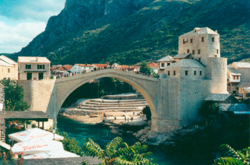
Bosnia and Herzegovina has been a top performer in recent years in terms of tourism development; tourist arrivals have grown by an average of 24% annually from 1995 to 2000 (360,758 in 2002, 500,000 in 2006).
According to an estimation of the World Tourism Organization, Bosnia and Herzegovina will have the third highest tourism growth rate in the world between 1995 and 2020.
Lonely Planet, in ranking the best cities in the world, ranked Sarajevo, the national capital and host of the 1984 Winter Olympic Games, as #43, ahead of Dubrovnik at #59, Ljubljana at #84, Bled at #90, Belgrade at #113, and Zagreb at #135. Tourism in Sarajevo is chiefly focused on historical, religious, and cultural aspects (see Sites of interest in Sarajevo). Bosnia has also become an increasingly popular skiing and Ecotourism destination .
More recently, the town of Visoko has experienced a major increase in tourist arrivals due to the alleged discovery of the Bosnian pyramids, attracting in excess of 10,000 tourists in the first weekend of June 2006.
Some of the tourist attractions in Bosnia and Herzegovina include:
- Banja Luka, the "Green City";
- Bihać and the Una River;
- Jajce and its waterfall;
- Medjugorje, site of an alleged Marian apparition;
- Mostar, the site of Stari Most;
- Mount Bjelašnica and Jahorina, sites of the XIV Olympic Winter Games.
- Neum on the coast;
- Sarajevo on the new Project City.
- Stolac, the Begovina neighbourhood and Radimlja tombstones;
- Višegrad and its old bridge;
- Visoko, site of the alleged Bosnian pyramids
Education
Primary education lasts for nine years. Secondary education is provided by general and technical secondary schools where studies last for four years. All forms of secondary schooling include an element of vocational training. Pupils graduating from general secondary schools obtain the Matura and can enroll in any faculty or academy by passing a qualification examination prescribed by the institution. Students graduating technical subjects obtain a Diploma.
As part of the former Yugoslavia, Bosnia enjoyed a highly-developed educational system. Two of Bosnia’s natives were awarded Nobel Prizes: Vladimir Prelog, for chemistry in 1975 , and Ivo Andrić, for literature in 1961 .
The recent war created a "brain drain" and resulted in many Bosnians working in high-tech, academic and professional occupations in North America, Europe and Australia. Such situation is viewed as an economic opportunity for building a vibrant economy in today’s Bosnia. However, only few of Bosnia's diaspora are returning to Bosnia and Herzegovina with their experience, Western education and exposure to modern business practices. Most still lack professional incentives to justify widespread and permanent return to their homeland.
Bosnia's current educational system with seven universities, one in every major city, plus satellite campuses—continues to turn out highly-educated graduates in math, science and literature. However, they have not been modernized in last 15 years due to war, various political and economic reasons and as a result do not meet Western educational standards which are part of criteria for EU membership. The need for reform of current Bosnian education system is generally acknowledged although specific methods for its change have still not been formulated.
Demographics
In 1910 Bosnia and Herzegovina had a population of 1,898,044 where 825,918 (43.49%) were Orthodox, 612,137 were Muslims (32.25%), 434,061 were Catholics (22.87%) and 26,428 (1.39%) others.
According to the 1931 census, there were 2,323,555 persons in Bosnia and Herzegovina: Orthodox 1,028,139 (44.25%); Muslims 718,079 (30.90%); Catholics 547,949 (23.58%); other: 29,388 (1.27%) of the total population.
The list of victims of the 1941-1945 war, made in 1964, is kept in the Documentation of the Federal Bureau of Statistics in Belgrade. It contains the names of 179,173 persons killed in the war born in Bosnia and Herzegovina. This list is not complete.
Large population migrations during the Yugoslav wars in the 1990s have caused a large demographic shift in the country. No census has been taken since 1991, and none is planned for the near future due to political disagreements. Since censuses are the only statistical, inclusive, and objective way to analyze demographics, almost all of the post-war data is simply an estimate. Most sources, however, estimate the population at roughly 4 million (representing a decrease of 350,000 since 1991).
According to the 1991 census, Bosnia and Herzegovina had a population of 4,377,033. Ethnically, 1,902,956 (43.47%) were Muslims by nationality, 1,366,104 (31.21%) Serbs, and 760,852 (17.38%) Croats, with 242,682 (5.54%) Yugoslavs and 104,439 (2.38%) others and unknown. According to 2000 data from the CIA World Factbook, Bosnia and Herzegovina is ethnically 48% Bosniak, 37.1% Serb, 14.3% Croat and 0.6% Other.
There is a strong correlation between ethnic identity and religion in Bosnia and Herzegovina. as is shown by the fact that 99% of Bosniaks are Muslims, 98% of Croats are Catholics whilst 99% of Serbs are Orthodox Christians. Tensions between the three constitutional peoples remain high in BiH and often provoke political disagreements.
According to the CIA World Factbook, Bosnia's largest ethnic groups are Bosniaks (48%), Serbs (37,1%) and Croats (14,3%). Likewise, 40% of the population are (Sunni) Muslims, 31% are Orthodox Christians, 15% are Roman Catholics, and 14% are atheists or have other religious affiliation.
Sports
The most important international sporting event in the history of Bosnia and Herzegovina was the hosting of the 14th Winter Olympics, held in Sarajevo from the 8th to the 23rd of February 1984.
Bosnia and Herzegovina has produced many athletes. Many of them were famous in the Yugoslav national teams before Bosnia and Herzegovina's independence.
Some notable local Olympians were:
- Rome, 1960: Tomislav Knez and Velimir Sombolac (football),
- Munich, 1972: Abaz Arslanagić, Milorad Karalić, Nebojša Popović, Đorđe Lavrinić, Dobrivoje Seleć (handball)
- Moscow, 1980: Mirza Delibašić and Ratko Radovanović (basketball)
- Los Angeles, 1984: Zdravko Rađenović, Zlatan Arnautović (handball) and Anto Josipović (boxing.
The Borac handball club has won seven Yugoslav National Championships, as well as the European Championship Cup in 1976 and the International Handball Federation Cup in 1991.
The Bosna basketball club from Sarajevo were European Champions in 1979. The Yugoslav national basketball team, which medaled in every world championship from 1963 through 1990, included Bosnian players such as Dražen Dalipagić and Mirza Delibašić. Bosnia and Herzegovina regularly qualifies for the European Championship in Basketball. Jedinstvo Women's basketball club, based in Tuzla, has won the 1979 European Championships in Florence.
The Tuzla-Sinalco karate club from Tuzla has won the most Yugoslav championships, as well as four European Championships and one World Championship.
The Bosnian chess team has been Champion of Yugoslavia seven times , in addition to winning four European championships: 1994 in Lyon, 1999 in Bugojno, 2000 in Neum, and 2001 in Kalitea. Borki Predojević (from Teslić) chess club has also won two European Championships: Litohoreu (Greece) in 1999, and Kalitei (Greece) in 2001.
Middle-weight boxer Marjan Beneš has won several B&H Championships, Yugoslavian Championships and the European Championship. In 1978 he won the World Title against Elish Obeda from Bahamas. Another middle-weight boxer, Ante Josipović won the Olympic Gold in Los Angeles, 1984. He also won Yugoslavian Championship in 1982, the Championship of the Balkans in 1983, and the Beograd Trophy in 1985.
Football is most popular sport in B&H. It dates from 1903, but its popularity grew significantly after the World War II. At local level, Sarajevo (1967 and 1984), Željezničar (1972) have both won the Yugoslavian Championship. The former Yugoslav national football team has included a number of Bosnian players, such as Josip Katalinski, Dušan Bajević, Ivica – Ćiro Blaževć, Ivica Osim, Safet Sušić, and Mirsad Fazlagić.
In football, the independent Bosnia and Herzegovina national football team has not qualified for a European or World Championship. Bosnian national teams have struggled to draft the best national players. Many players born in Bosnia and Herzegovina choose to play for other countries due to their ethnic identification and because of higher salaries offered by other teams. For example Mario Stanić and Mile Mitić were both born in Bosnia, but play for Croatia and Serbia respectively. Other internationally famous players from Bosnia and Herzegovina, who have made similar choices, are: Zoran Savić, Vladimir Radmanović, Zoran Planinić , Aleksandar Nikolić and Savo Milošević.
Bosnia and Herzegovina is the current world champion in paralympic volleyball. Many of the players lost their legs in the War of 1992-1995.


